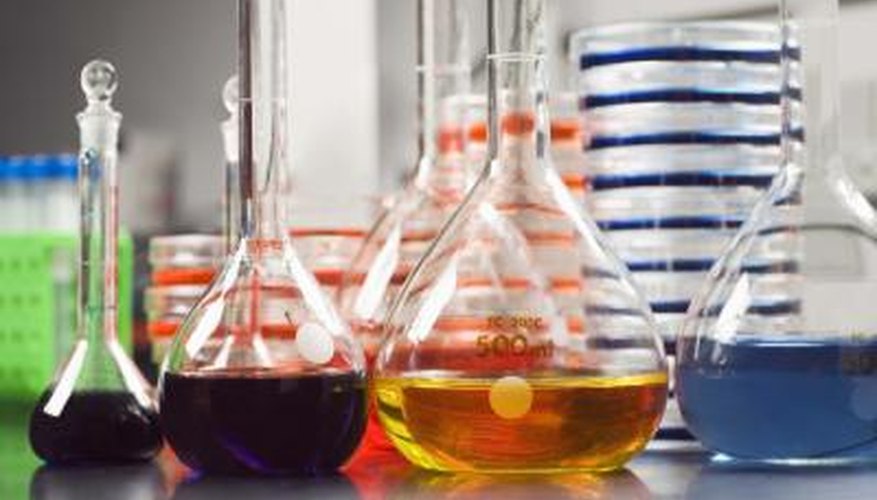According to the second law of thermodynamics, all molecules in a closed system tend to go from order to disorder. Following this law, diffusion is the movement of molecules from an area of high concentration to an area of low concentration. As the molecules diffuse, they become more disorderly. Osmosis is a special case of diffusion. In osmosis, water diffuses through a semipermeable membrane from an area of low solute concentration to an area of high solute concentration. This might seem to be the opposite of diffusion, but here, water is actually moving from an area of higher water concentration to an area of lower water concentration. Tonicity is the measure of relative concentrations. A hypertonic solution has more solute than its surroundings, a hypotonic solution has less solute than its surroundings and an isotonic solution has the same concentration as its surroundings. You can compute the percentage of diffusion and osmosis in the lab given any initial concentrations of water and solute.
- According to the second law of thermodynamics, all molecules in a closed system tend to go from order to disorder.
- Following this law, diffusion is the movement of molecules from an area of high concentration to an area of low concentration.
Cut four 30cm lengths of dialysis tubing. Tie a knot in one end of each length, forming four bags. Soak the bags in distilled water for five minutes.
Calculate the molecular weight of the solute. You may use common table sugar, sucrose. The chemical formula is: C12H22O11. The molecular weight is calculated by multiplying the weight of each atom by the quantity of each atom in the molecule. Obtain the atomic weights from the periodic table. Carbon, C, weighs 12.01; hydrogen, H, weighs 1.01; oxygen, O, weighs 16.00. In sucrose, the mass of carbon is 12.01 x 12 = 144.12. The mass of hydrogen is 1.01 x 22 = 22.22. The mass of oxygen is 16.00 x 11 = 176. Thus, the molecular weight of sucrose is 144.12 + 22.22 + 176 = 342.3.
- Cut four 30cm lengths of dialysis tubing.
- In sucrose, the mass of carbon is 12.01 x 12 = 144.12.
Make the solutions. For this experiment, make the following solutions, where M = molarity: 1.0 M sucrose, 0.5 M sucrose and 0.2 M sucrose. A 1.0 M solution is the molecular weight of solute dissolved in 1 litre of solvent. Thus, a 1.0 M sucrose solution would be 342.3 grams sucrose dissolved into 1 litre distilled water. Here, use 200ml of water instead. So, to make the 1 M solution dissolve 342.3 grams/1L x 0.2 L water = 68.46 grams sucrose. Add the sucrose to a beaker and fill with distilled water until the total solution is 200ml. Mix.
- For this experiment, make the following solutions, where M = molarity: 1.0 M sucrose, 0.5 M sucrose and 0.2 M sucrose.
- Thus, a 1.0 M sucrose solution would be 342.3 grams sucrose dissolved into 1 litre distilled water.
Repeat Step 3 for each of the remaining solutions. To make a 0.5 M solution: 0.5 x 342.3 grams/1L x 0.2 L = 34.23 grams sugar filled to make a 200ml solution. To make a 0.2 M solution: 0.2 x 342.3 grams/1L x O.2 L = 13.69 grams sugar filled to make a 200ml solution.
- Repeat Step 3 for each of the remaining solutions.
- To make a 0.2 M solution: 0.2 x 342.3 grams/1L x O.2 L = 13.69 grams sugar filled to make a 200ml solution.
Fill the dialysis bags 2/3 full with the solutions. Add 1 solution per bag: bag 1 with 1 M solution, bag 2 with 0.5 M solution, bag 3 with 0.2 M solution and bag 4 with distilled water. Tie the other end of the bag, leaving plenty of room for expansion. Rinse each bag with distilled water and blot dry. Weigh each bag. Record the weights.
Fill four beakers 2/3 full with distilled water. Place each bag into its own beaker and label the beaker with the bag number. Let stand for 30 minutes. Remove each bag, dry carefully and weigh. Record the weight of each bag.
Subtract the final mass of each bag from the initial mass of each bag. Multiply times 100 and divide the total by initial mass. This is the percentage change in mass. Note that in bag 4, there is no change in mass. Osmosis did not take place.
- Fill four beakers 2/3 full with distilled water.
- Subtract the final mass of each bag from the initial mass of each bag.
Make a graph with molarity on one axis and percntage change on the other. Note the trend. Bags 1 through 3 were hypertonic to the solution. The more concentrated the solution, the more water moved by osmosis into the bag, and thus the greater the increase in weight.
Repeat the experiment, filling the bags with distilled water and the beakers with sugar solutions. Calculate the percentage change and graph. In this case, the water in the bags are hypotonic to the solutions in the beakers. Water thus moved by osmosis out of the bags and into the solution. You can use any solute that will dissolve in water. Try the experiment with table salt.
- Make a graph with molarity on one axis and percntage change on the other.
- In this case, the water in the bags are hypotonic to the solutions in the beakers.
